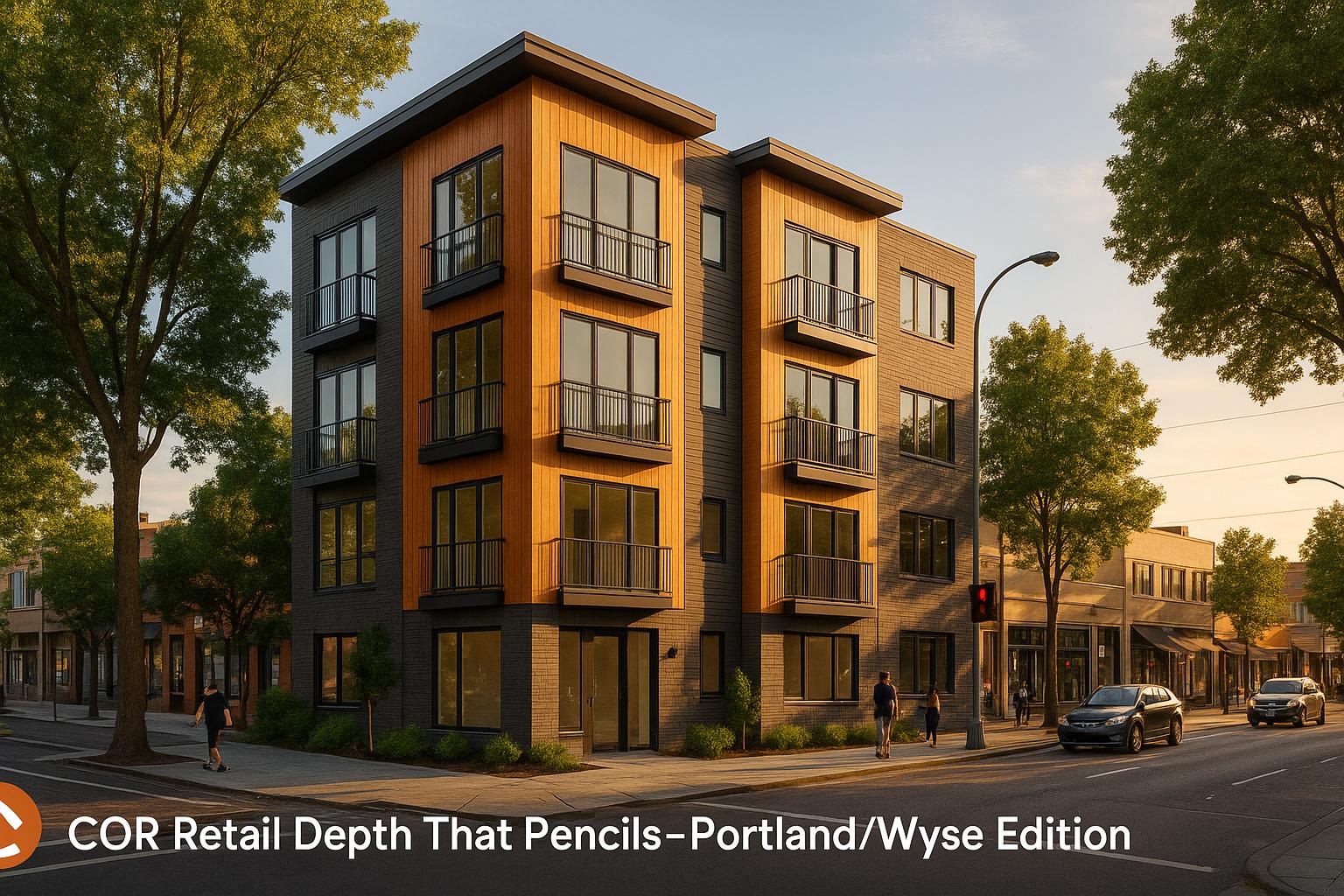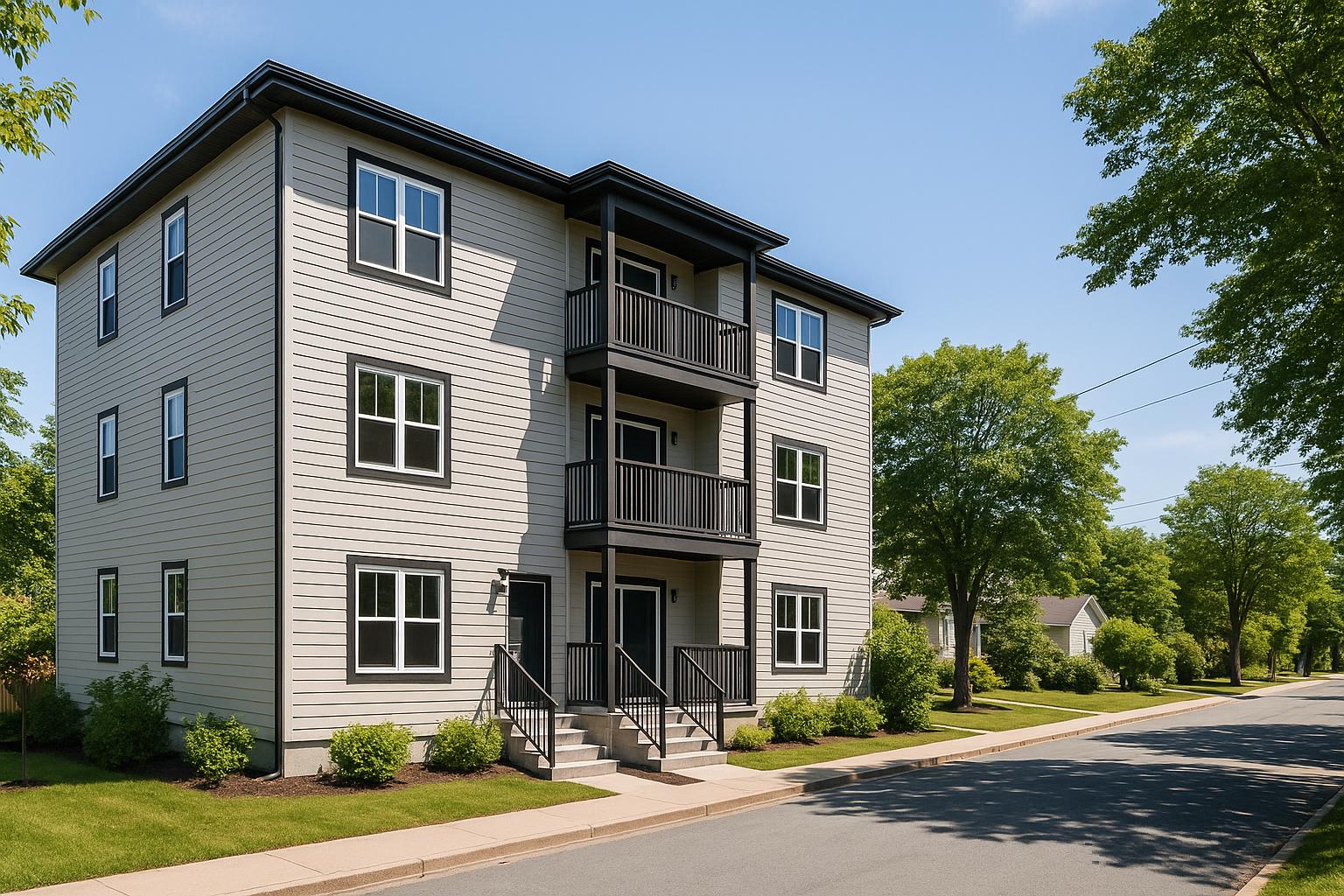Building a multi-unit rental property in Dartmouth can be a minefield of delays, rejections, and cost overruns. Here’s the reality: without careful planning, an 8-month project can easily stretch to 18 months. The key challenges boil down to:
- Zoning rules: Missteps with density, parking, height limits, or setbacks can halt your project.
- Building codes: Accessibility, fire safety, and energy efficiency requirements are strict and evolving.
- Utility connections: Delays in approvals for water, sewer, and power can derail timelines.
- Permit applications: Incomplete or inaccurate submissions are a common pitfall.
Every delay costs you income - up to $8,400/month for a fourplex at $2,100/unit. Miscommunication between your architect, engineer, and contractor can further inflate costs by 30–60%.
The solution? Get zoning confirmed early, hire local experts, and consider an integrated design-build approach to streamline approvals and construction. This guide breaks down how to avoid common traps and keep your project on track.
(The Lack of) Building Permits in Halifax, Nova Scotia: Canada's Open Secret.
Dartmouth Zoning and Land Use Requirements
Dartmouth’s zoning regulations operate under the Halifax Regional Municipality (HRM) planning framework [2]. The HRM Centre Plan has updated these rules, creating both new possibilities and potential challenges [2]. Whether you’re planning to invest in land or start a design project, understanding these evolving requirements is a crucial first step.
Multi-unit developments in Dartmouth are often assessed based on building height limits, minimum lot sizes, density calculations, and parking requirements [1]. For instance, recent updates in the Brightwood Community along Victoria Road raised height limits from 5 to 7 storeys [3].
Start by confirming the zoning rules that apply to your property. Overlooking or misinterpreting these regulations can lead to costly redesigns and delays. Below, we’ll explore common zoning mistakes that can halt projects and how to avoid them.
Common Zoning Mistakes That Stop Projects
Several missteps can derail a project before it even begins. Here are the most frequent issues:
- Incorrect density calculations: Density rules determine how many housing units can be built on a piece of land. Misjudging lot areas or setbacks can lead to errors in these calculations, causing delays or rejections [1].
- Parking requirement violations: Dartmouth enforces strict off-street parking minimums, particularly in urban areas, to manage congestion. These requirements vary by zoning district and the number of units in your development [1].
- Setback miscalculations: Setback rules ensure buildings are positioned at a safe and visually acceptable distance from property lines. Missteps here can result in costly redesigns during the approval process [3].
- Building height violations: Misreading zoning maps or overlooking recent Centre Plan updates can lead to exceeding height limits. These limits often differ significantly between districts, even within a few blocks [2].
- Greenspace oversights: Many zoning codes require a portion of the property to be allocated for landscaping or open space. Failing to meet these standards can stall your project [1].
Being aware of these pitfalls is the first step. The next is learning how to navigate the zoning process effectively.
How to Meet Zoning Requirements
To avoid zoning-related headaches, follow these steps to ensure compliance:
- Consult the Halifax Regional Municipality planning department: Scheduling a pre-application meeting can provide clarity on zoning requirements. These meetings allow you to discuss your project concept, address potential conflicts early, and understand how recent Centre Plan updates may impact your plans [1].
- Review zoning codes and seek professional advice: Local zoning codes outline detailed restrictions on building height, lot size, parking, and setbacks. Engaging zoning experts, such as attorneys or urban planners, can help you interpret complex regulations and align your project with local standards [1].
- Prepare for rezoning if necessary: If your property’s current zoning doesn’t permit multi-unit construction, you may need to apply for rezoning. This process often involves submitting detailed site plans and attending public hearings, which can extend your project timeline [1].
- Design beyond the minimum standards: Aim to exceed the baseline requirements for height, density, parking, and setbacks. This approach minimizes the risk of rejection due to minor discrepancies and can streamline the approval process.
Nova Scotia Building Code and Accessibility Compliance

Once you've tackled zoning regulations, the next hurdle in securing project approval is ensuring your construction aligns with Nova Scotia's building codes.
These codes lay out strict guidelines for structural safety, energy efficiency, and accessibility. For multi-unit projects, the challenge grows as both national and provincial standards evolve, adding layers of complexity to the process.
Meeting these requirements is non-negotiable. Failing inspections can lead to frustrating delays and unplanned expenses.
Common Building Code Issues That Cause Delays
In multi-unit construction, some of the most frequent code violations stem from accessibility, fire safety, and energy efficiency concerns.
Accessibility compliance is critical. This includes barrier-free access, properly designed parking spaces, ramps with appropriate slopes, wide doorways, and accessible washrooms. Falling short in any of these areas can result in inspection setbacks.
Fire safety regulations are another common stumbling block. Multi-unit buildings must meet compartmentalization and egress standards. This means ensuring proper fire separations and implementing emergency systems like pressurization, lighting, and clearly marked exits. Poorly planned fire safety measures often lead to costly revisions.
Energy efficiency requirements have also become more stringent. Updated provincial codes demand modern insulation, air barriers, and mechanical ventilation. Relying on outdated methods can result in delays when these elements fail to meet current standards.
Additionally, plans that don’t account for updated foundation or seismic standards can lead to setbacks, as they may no longer align with today's requirements.
How to Stay Code-Compliant
Avoiding delays and ensuring compliance starts with a proactive approach. Here’s how to keep your project on track:
- Engage Experts Early: Bring in structural engineers, accessibility consultants, and energy efficiency specialists during the design phase. Their expertise can help identify potential issues before they escalate into costly problems.
- Keep Designs Up-to-Date: Building codes change frequently. Regularly review your designs against the latest standards to ensure they meet current regulations.
- Document Everything Clearly: Detailed construction documentation that outlines how your project meets accessibility, fire safety, energy efficiency, and structural standards can make inspections smoother and reduce room for disputes.
- Plan for Phased Inspections: Rather than waiting for a final review, schedule inspections throughout the construction process. This allows for early identification and correction of non-compliance issues, minimizing delays.
- Partner with Local Specialists: Work with professionals experienced in multi-unit projects and familiar with Nova Scotia’s codes and inspection practices. Their knowledge can help you navigate potential pitfalls and streamline the approval process.
Taking these steps can help you avoid common setbacks and move your project forward with fewer interruptions.
Utility Connection Approvals and Timelines
Once your project meets building codes, the next step is securing approvals for utility connections. These include water, sewer, and electrical hookups, each requiring separate documentation and timelines. Many property owners underestimate how long this process can take, leading to construction delays. Planning ahead and understanding the steps involved can help avoid setbacks.
Why Utility Approvals Get Delayed
Delays often occur due to incomplete applications or poor timing. For example, Halifax Water typically processes new service connections within five business days, while Nova Scotia Power requires at least 10 days' notice [4][5]. For multi-unit dwellings, the process becomes more complex as it must also go through the Halifax Building Permit Process, adding extra layers of approval [4]. Additionally, any new or modified electrical installations need permits issued by the appropriate local utilities [6].
To avoid delays, submit all utility applications at the same time and ensure that your documentation is complete. This includes site plans, engineering drawings, and environmental assessments. Missing or incorrect information is one of the most common reasons for approval delays.
How to Speed Up Utility Approvals
To keep your project on track, adopt a proactive approach to utility approvals. Start by engaging with utility providers early in your planning process. For instance, reaching out to Halifax Water can help confirm the availability of water, wastewater, and stormwater services for your property [4]. This early communication can reveal potential issues before you invest time and resources into detailed applications.
Submitting all utility applications simultaneously is another effective strategy. By aligning Halifax Water's five-business-day review period with Nova Scotia Power's 10-day notice requirement, you can save valuable time.
Ensure that your documentation is thorough and accurate. Double-check that all forms are fully completed and signed to prevent delays caused by missing or outdated information. Each utility provider has specific requirements, so preparing a comprehensive package tailored to their needs is critical.
It’s also a good idea to contact Halifax Water, Nova Scotia Power, and the HRM Planning & Development Permit Office early in the process. Clarifying their requirements and identifying potential challenges ahead of time can help you avoid unexpected roadblocks.
If navigating these processes feels overwhelming, consider working with professionals who are familiar with local regulations. Experts in land-use planning, environmental compliance, and utility approvals in Dartmouth can provide valuable advice and help you address regulatory concerns efficiently.
sbb-itb-16b8a48
Permit Applications: Avoiding Common Mistakes
Getting permits approved quickly depends on meeting Dartmouth's specific municipal requirements. Delays often happen when applications are incomplete, leading to extended timelines and higher costs.
Common Errors That Lead to Permit Rejections
- Missing required studies: Forgetting critical reports like traffic impact analyses, stormwater management plans, or environmental assessments can stall your project. Many property owners only learn about these requirements after submitting their application, which forces them to start over.
- Incomplete forms or documents: Missing technical drawings, site plans, or engineering calculations can result in outright rejections. Even minor formatting mistakes can reset the review process.
- Skipping pre-application feedback: Ignoring advice from early planning meetings can increase the chances of rejection. These sessions are meant to guide you, so it’s essential to reflect any recommendations in your final submission.
- Assuming zoning compliance: Failing to confirm that your project aligns with local zoning rules - like density limits, setbacks, or parking requirements - can lead to unexpected setbacks.
- Misjudging parking needs: For multi-unit buildings, accurate parking calculations for residents and visitors are critical. Overlooking this detail is a frequent mistake.
Avoiding these errors requires a detail-oriented and methodical approach.
Tips for Successful Permit Applications
To improve your chances of approval, consider these strategies:
- Hire experienced professionals: Work with design-build teams familiar with Dartmouth’s requirements. They know what documents are necessary and how to format them correctly.
- Tailor your documents: Use templates and formats that align with Dartmouth’s specific standards for site plans, architectural drawings, and technical details.
- Schedule pre-application meetings: Meet with planning staff early to identify potential issues. Take detailed notes during these sessions and incorporate their feedback into your application.
- Use a checklist: Prepare a complete package of all required studies and documents. A municipal checklist can help ensure nothing important is overlooked.
- Double-check your application: Have someone not involved in the preparation review your submission. They can catch small errors, like missing signatures, incorrect dates, or miscalculations, that could result in rejection.
- Submit early: Filing your application at the start of the review cycle gives you extra time to address any additional requests from the planning department.
Thorough preparation and attention to local requirements can mean the difference between a smooth approval process and frustrating delays for your project.
Traditional Construction vs Integrated Design-Build
In Dartmouth, traditional construction methods often lead to coordination headaches that can derail multi-unit rental projects. The conventional process involves hiring separate professionals for planning, architecture, engineering, and construction. This fragmented approach frequently results in miscommunication and delays, sometimes halting projects before they even reach the approval stage.
Here’s a closer look at how traditional methods compare to an integrated design-build approach.
Construction Method Comparison
Traditional construction requires property owners to juggle multiple contractors, which often leads to coordination breakdowns, budget overruns of 30–60%, and extended project timelines. What might start as an 8-month plan can balloon to over 18 months. Each delay compounds the next, creating a domino effect that can derail municipal review timelines.
On top of that, cost-plus pricing adds financial uncertainty. Contractors may quote low to win the job but later hit property owners with unexpected change orders and overruns once construction begins. This makes it nearly impossible for owners to predict final costs, leaving financial planning in disarray.
Integrated design-build solves these issues by uniting planners, architects, engineers, and construction teams under one umbrella. Instead of managing multiple contracts and hoping for smooth communication, property owners gain single-source accountability and streamlined cost management right from the start.
Benefits of Integrated Design-Build
The integrated design-build approach tackles the challenges of traditional methods by combining all necessary expertise within one team.
- Fixed pricing: This approach removes the budget uncertainty typical of traditional construction. By involving design and construction teams from the outset, costs are accurately predicted and locked in before breaking ground. On average, property owners save $47,000 in coordination waste per project.
- Guaranteed timelines: Integrated firms offer contractual guarantees for on-schedule completion, with penalties for delays. For example, Helio Urban Development commits to a 6-month timeline, backing it with penalties of up to $1,000 per day if they miss the deadline.
- Single accountability: With one company responsible for the entire project, there’s no room for finger-pointing when issues arise. In traditional methods, problems often become blame games among architects, engineers, and builders. Integrated design-build eliminates this by centralizing responsibility.
- Improved quality control: When the same team handles both design and construction, potential issues are identified and resolved early in the design phase, avoiding costly corrections later. Traditional projects, by contrast, often suffer from miscommunication between designers and builders, leading to expensive fixes during construction.
Additionally, integrated design-build firms streamline the municipal approval process by creating plans optimized for both approval speed and construction efficiency. This prevents the common pitfall of designing beautiful plans that are impractical to build within budget or timeline constraints.
Property owners who work with integrated design-build firms report zero finger-pointing across projects because there’s only one company to hold accountable. This clarity extends to warranty issues, where traditional construction often leaves owners chasing multiple contractors for repairs. With integrated teams, the process is smoother and more reliable from start to finish.
Your Action Plan for Dartmouth Approval Success
Getting through Dartmouth's approval process smoothly takes careful planning and a clear strategy. By following these steps, property owners can avoid delays that often disrupt multi-unit projects.
Verify zoning from the start. Before you dive into design work, confirm your property's zoning classification with Dartmouth's zoning office. Many property owners mistakenly believe their land is ready for multi-unit construction, only to find out later that rezoning is necessary. This misstep can add significant delays and unexpected costs to your project [1].
Bring in professional help early. A zoning attorney or urban planner can be invaluable when navigating Dartmouth's complex zoning regulations. Their expertise ensures your project complies with local rules right from the start [1]. Once zoning requirements are clear, focus on assembling a strong permit application.
Submit a complete application package. Your permit application should include detailed descriptions of the project, the intended use, and proper land identification using the Parcel Identifier (PID) or assessment account number. Ensure your plans align with National Building Code standards and include all necessary professional contacts, project valuation, and fees. Incomplete applications can lead to frustrating delays or outright rejections [7].
Start utility approvals early. Reach out to Nova Scotia Power, Halifax Water, and other utility providers as soon as possible. Securing utility connections for multi-unit properties can take longer than expected, especially if upgrades to service capacity are needed. Getting this step underway early helps avoid construction delays down the line.
Consider an integrated design-build approach. Traditional construction methods often involve juggling multiple professionals, which can lead to miscommunication and delays. Integrated design-build firms simplify this process by combining key professionals under one contract. This approach offers fixed pricing and clear timelines, reducing coordination risks during the approval process.
Engage with the community early. Proactively connect with neighbours and local groups to address concerns about traffic, noise, or changes to the neighbourhood. Building goodwill and support before formal hearings can ease the approval process and minimize opposition during public consultations [1].
Careful preparation and teamwork are the keys to success in Dartmouth's approval process. By staying informed about local requirements, submitting thorough applications, and working with experienced professionals, property owners can avoid costly setbacks and keep their multi-unit projects on track.
FAQs
What are the advantages of using a design-build approach for multi-unit construction in Dartmouth?
Choosing the design-build method for multi-unit construction projects in Dartmouth comes with some clear benefits compared to traditional approaches. By merging the design and construction phases into one cohesive process, projects can be completed 6% to 12% faster. This means your property can hit the market sooner, saving time and helping you stay ahead in a competitive environment. Plus, this integrated approach fosters better communication and teamwork, cutting down on delays and preventing costly missteps.
Another big advantage of the design-build model is its ability to keep costs in check. With a single team overseeing both the design and construction, budgeting becomes more accurate, and surprises - like unexpected expenses - are less likely to arise. For property owners in Dartmouth, where navigating approval processes and local regulations can be tricky, this streamlined method offers a more efficient and reliable path to completion.
What steps can property owners in Dartmouth take to meet zoning and land use requirements and avoid project delays?
To navigate zoning and land use requirements in Dartmouth without unnecessary delays, start by diving into the Halifax Regional Municipality's Land Use By-law for Dartmouth. This resource lays out the zoning rules and permitted uses, giving you a clear picture of whether your project fits within local regulations. It’s also crucial to familiarize yourself with Dartmouth’s zoning map and classifications, like residential, commercial, or mixed-use zones.
Connecting early with municipal planning offices is a smart move. They can help clarify specific requirements and flag any potential hurdles. If the process feels overwhelming, consider bringing in professionals who have experience with Dartmouth’s regulatory landscape. They can assist in preparing detailed application packages and ensure everything aligns with local standards. Taking these steps upfront can save you time and help you avoid expensive setbacks down the road.
What causes delays in utility connections for multi-unit construction projects, and how can these be avoided?
Delays in getting utilities connected during multi-unit construction projects in Dartmouth, Nova Scotia, often stem from late-stage planning, scheduling conflicts, and backlogs with utility providers. These delays can push connection times to over two months, throwing project timelines off course.
To sidestep these issues, it’s crucial to engage with utility providers early in the pre-construction phase. Take time to conduct thorough site evaluations to pinpoint potential challenges and develop a detailed, realistic schedule for utility relocations. Consistent and transparent communication with utility providers is key, along with securing all necessary approvals well in advance. With proactive planning, you can reduce costly delays and keep your project moving smoothly.



